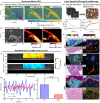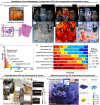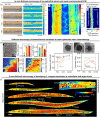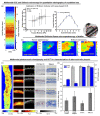Recent advances in optical elastography and emerging opportunities in the basic sciences and translational medicine [Invited]
- PMID: 36698669
- PMCID: PMC9842001
- DOI: 10.1364/BOE.468932
Recent advances in optical elastography and emerging opportunities in the basic sciences and translational medicine [Invited]
Abstract
Optical elastography offers a rich body of imaging capabilities that can serve as a bridge between organ-level medical elastography and single-molecule biophysics. We review the methodologies and recent developments in optical coherence elastography, Brillouin microscopy, optical microrheology, and photoacoustic elastography. With an outlook toward maximizing the basic science and translational clinical impact of optical elastography technologies, we discuss potential ways that these techniques can integrate not only with each other, but also with supporting technologies and capabilities in other biomedical fields. By embracing cross-modality and cross-disciplinary interactions with these parallel fields, optical elastography can greatly increase its potential to drive new discoveries in the biomedical sciences as well as the development of novel biomechanics-based clinical diagnostics and therapeutics.
© 2022 Optica Publishing Group under the terms of the Optica Open Access Publishing Agreement.
Conflict of interest statement
The authors declare that there are no conflicts of interest related to this article.
Figures










Similar articles
-
Optical coherence elastography - OCT at work in tissue biomechanics [Invited].Biomed Opt Express. 2017 Jan 27;8(2):1172-1202. doi: 10.1364/BOE.8.001172. eCollection 2017 Feb 1. Biomed Opt Express. 2017. PMID: 28271011 Free PMC article. Review.
-
Strain and elasticity imaging in compression optical coherence elastography: The two-decade perspective and recent advances.J Biophotonics. 2021 Feb;14(2):e202000257. doi: 10.1002/jbio.202000257. Epub 2020 Nov 3. J Biophotonics. 2021. PMID: 32749033 Review.
-
Magnetomotive Optical Coherence Elastography for Magnetic Hyperthermia Dosimetry Based on Dynamic Tissue Biomechanics.IEEE J Sel Top Quantum Electron. 2016 Jul-Aug;22(4):6802816. doi: 10.1109/JSTQE.2015.2505147. Epub 2015 Dec 17. IEEE J Sel Top Quantum Electron. 2016. PMID: 28163565 Free PMC article.
-
Optoacoustic mesoscopy for biomedicine.Nat Biomed Eng. 2019 May;3(5):354-370. doi: 10.1038/s41551-019-0377-4. Epub 2019 Apr 15. Nat Biomed Eng. 2019. PMID: 30988470 Review.
-
The future of cerebral surgery: a kaleidoscope of opportunities.Neurosurgery. 2008 Jun;62(6 Suppl 3):1555-79; discussion 1579-82. doi: 10.1227/01.neu.0000333820.33143.0d. Neurosurgery. 2008. PMID: 18695575
Cited by
-
Laser speckle rheological microscopy reveals wideband viscoelastic spectra of biological tissues.Sci Adv. 2024 May 10;10(19):eadl1586. doi: 10.1126/sciadv.adl1586. Epub 2024 May 8. Sci Adv. 2024. PMID: 38718128 Free PMC article.
-
Chirp excitation for natural frequency optical coherence elastography.Biomed Opt Express. 2024 Sep 13;15(10):5856-5871. doi: 10.1364/BOE.536685. eCollection 2024 Oct 1. Biomed Opt Express. 2024. PMID: 39421777 Free PMC article.
-
Beyond Water Content: Unraveling Stiffness in Hydrated Materials by a Correlative Brillouin-Raman Approach.ACS Photonics. 2025 Jun 21;12(7):3794-3802. doi: 10.1021/acsphotonics.5c00808. eCollection 2025 Jul 16. ACS Photonics. 2025. PMID: 40688183 Free PMC article.
-
Multimodal mechano-microscopy reveals mechanical phenotypes of breast cancer spheroids in three dimensions.APL Bioeng. 2024 Sep 9;8(3):036113. doi: 10.1063/5.0213077. eCollection 2024 Sep. APL Bioeng. 2024. PMID: 39257700 Free PMC article.
-
In-vivo characterization of scleral rigidity in myopic eyes using fundus-pulsation optical coherence elastography.Biomed Opt Express. 2024 Apr 29;15(5):3426-3440. doi: 10.1364/BOE.523835. eCollection 2024 May 1. Biomed Opt Express. 2024. PMID: 38855699 Free PMC article.
References
Publication types
LinkOut - more resources
Full Text Sources
